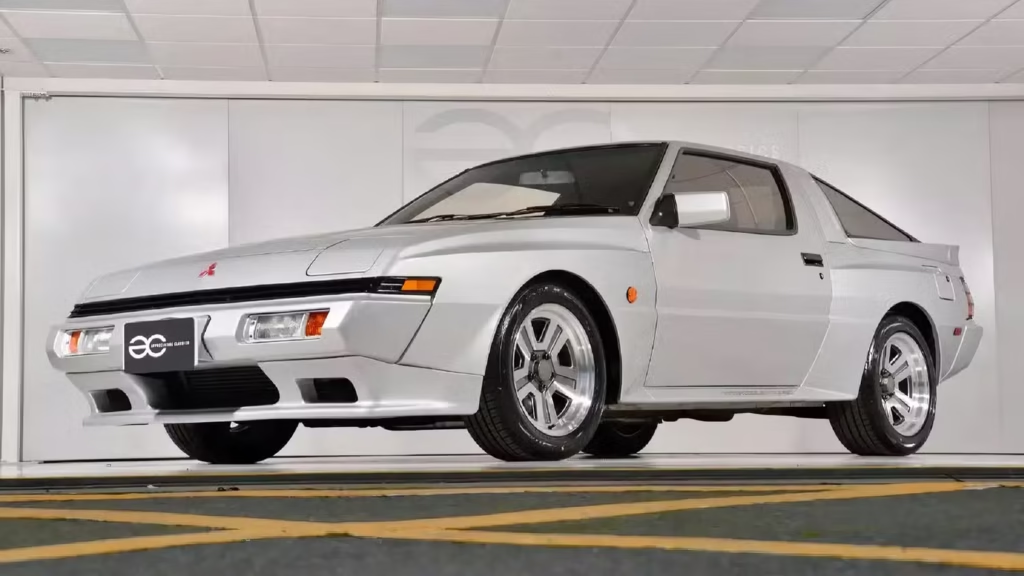Before Mitsubishi made its name in rallying with the iconic Lancer Evolution series, the brand dipped its toes into performance waters with a bold, turbocharged coupe that has since faded into obscurity. The Mitsubishi Starion GSR-VR was everything a 1980s performance enthusiast could ask for—fast, aggressive, innovative—and yet, it never set foot on American soil in its most thrilling form.
While names like the Nissan GT-R and Toyota Supra have cemented their legacy thanks to motorsport victories and pop culture fame, the Starion GSR-VR has been largely forgotten, overshadowed by both its rivals and Mitsubishi’s own later success. But make no mistake: this was a serious machine, engineered for speed, and worthy of far more recognition than it received.
The Starion GSR-VR: Mitsubishi’s Early Shot at Greatness
Launched in 1984, the Mitsubishi Starion GSR-VR was created as a homologation special for the ferocious Group B rally category. Though Group B would soon be shuttered due to its dangerous intensity, the GSR-VR survived as a potent reminder of what could have been.

It was the most hardcore version of the Starion lineup, a rear-wheel-drive turbo coupe that stood apart with a wide body, flared fenders, and an unmistakably aggressive stance. This was Mitsubishi’s answer to the likes of the Mazda RX-7 and Nissan 300ZX—only sharper and more radical.
Under the hood, it packed a turbocharged 2.0-liter inline-four (the G63B engine), which would later serve as the foundation for the early Lancer Evos. Producing around 200 horsepower and over 200 lb-ft of torque, it was capable of 0–60 mph in about 6.5 seconds and a top speed north of 140 mph—impressive numbers for a 2,800-pound machine in the mid-80s.
But raw power wasn’t its only trick.
The GSR-VR featured four-wheel disc brakes (with optional ABS, a rarity at the time), MacPherson struts up front, and an independent rear suspension—components engineered for agility and sharp response. A limited-slip differential and close-ratio five-speed manual gearbox added to the car’s dynamic, driver-focused character.

Inside, it was all business. With digital gauges and heavily bolstered seats, the cockpit was built for control and clarity—ideal for a car designed with track days and twisty mountain roads in mind.
A Missed Opportunity for the U.S.
Despite the car’s capability and Mitsubishi’s growing global presence, the GSR-VR never made it to the United States. Regulatory hurdles, market priorities, and the perceived lack of interest in high-strung, high-cost Japanese performance cars meant that American buyers got a watered-down alternative.
Instead of the GSR-VR, U.S. consumers were offered the Mitsubishi Starion in milder trims—or, more notably, the Chrysler Conquest TSi. While visually similar in its later wide-body guise, the Conquest TSi was fundamentally different beneath the surface.
It used a larger 2.6-liter turbocharged four-cylinder engine, delivering between 145 and 188 horsepower depending on the year. While it offered decent torque, the engine was heavier, less refined, and not as free-revving as the G63B. Combined with a softer suspension setup and a grand tourer lean, the Conquest lacked the GSR-VR’s razor-sharp performance edge.

Ironically, the Conquest TSi’s lukewarm reception may have reinforced Mitsubishi’s belief that the full-fat GSR-VR wouldn’t have found an audience in America. But that decision also robbed the U.S. of one of the most unique sports cars of the era.
A Rare Gem Remembered
Fewer than 2,500 units of the GSR-VR were ever built, making it an elusive collector’s piece today. In Japan and among niche enthusiasts worldwide, it’s recognized for what it was: an underdog with serious capability, ahead of its time in both engineering and execution.
Its DNA lived on in later Mitsubishi legends. The G63B engine would evolve into the powerplant for the Galant VR-4 and eventually the Lancer Evolution—cars that would define Mitsubishi’s reputation for rally-bred performance in the ‘90s and early 2000s.

But the GSR-VR is where that lineage truly began. It didn’t need all-wheel drive or a massive wing to command respect. It relied on a pure, lightweight formula: rear-wheel drive, turbo power, and finely tuned handling.
Conclusion: A Legacy in the Shadows
The Mitsubishi Starion GSR-VR may have never conquered rally stages or starred in Hollywood blockbusters, but it deserves a place in the conversation about Japan’s greatest sports cars. It was bold in its design, sophisticated in its engineering, and thrilling to drive.
Had it reached American shores, the GSR-VR might have rewritten Mitsubishi’s stateside story. Instead, it remains one of the coolest cars the U.S. never got—a forbidden fruit now ripening into a classic that collectors and performance purists can only admire from afar.
It may have been forgotten by many, but for those who know, the Starion GSR-VR remains a symbol of what Mitsubishi was once brave enough to build.




